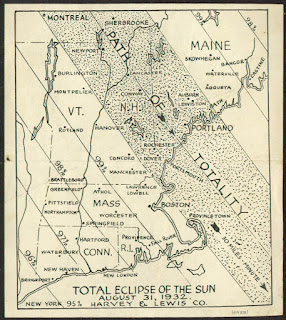Images of broken light which dance before me like a million eyes
They call me on and on across the universe
Let's hope we have better luck next week than we did in 1932! That was the last time that we had a solar eclipse come so near to us. Unlike the partial solar eclipse we will celebrate at our "eclipse party" on Monday, August 21 at 2 pm (please make a note the time change from our previous blog) the one eighty-five years ago was a total eclipse of the sun and drew astronomical expeditions from all over the country and the world.
Unfortunately, after all the work in preparation, clouds came in at the last minute largely obscuring the event.
No, this is not one of Einstein’s famous mathematical formulas for gravity or special relativity. It is from one of our history room founder’s, Keith Henney's, books - Handbook of Photography, from 1939.
And it represents what we will be making at our eclipse party as one of the oldest and simplest and safest and cheapest ways to observe a solar eclipse. Here is Mr. Henney's explanation of the diagram above.
Does that make it clear to you now? No, me neither.
How about another table from Mr. Henney's book?
Now we can get a sense of what he is talking about - a pinhole camera!
Even a partial eclipse like what we will have next Monday can be dangerous if you directly at it and we will be making pinhole cameras at our eclipse party so we can observe the event safely.
This is the same principle they used to watch the eclipse in Conway eighty-five years ago with slightly larger tubes than the cardboard boxes we will use. The one the Franklin Institute from Philadelphia set up in the fields behind Kennett High School (now Kennett Middle School) was eighty-five feet long.
Notice the familiar outline of the Moat Mountains in the background.
The picture below is from the Collections of the Van Vleck Observatory, Wesleyan University, courtesy of Roy Kilgard, Research Associate Professor of Astronomy. They set up their observatory in South Conway and used Kennett High School to do some of their work.
Remarkably, much of the original equipment they used in 1932 has survived and was recently restored. The photo below from facebook shows Amrys Williams in period costume taking a look through the refubished 20 inch Clark refractor to celebrate astronomer Dr. Frederick Slocum's birthday in 2016. Slocum used parts of this telescope in Conway in 1932 to study the eclipse.
Another telescope the Van Vleck observers used in Conway was their 6 inch refractor, currently on display in the foyer of their observatory. It dates to the 1830s and was briefly famous as the largest telescope of its times in the Americas.
To help place the upcoming eclipse into a historical context we have put together a small display at the library. One of the items featured is a copy of an article from the Boston Evening Transcript. Here are a couple interesting details.
So, hope to see you at our eclipse party next week. As always, if you have any questions or want to learn more about this subject, contact us at the Conway Public Library's Henney History Room.


















